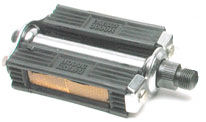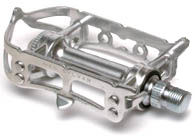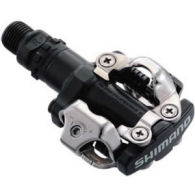Fahrradpedale: Unterschied zwischen den Versionen
(→Pedalgewinde: übersetzt) |
(→Gewindegrößen: typos) |
||
| Zeile 33: | Zeile 33: | ||
* Die meisten [[Pedal]]e haben 9/16" x 20 [[TPI]] Gewinde. | * Die meisten [[Pedal]]e haben 9/16" x 20 [[TPI]] Gewinde. | ||
* [[Fauber]] bzw. [[OPC]] Kurbeln haben 1/2" x 20 TPI Gewinde. | * [[Fauber]] bzw. [[OPC]] Kurbeln haben 1/2" x 20 TPI Gewinde. | ||
* Ältere [[französisch]]e Fahrräder hatten 14 mm x 1.25 mm Gewinde. Zum Glück sind diese aber sehr selten. Pedale mit französischem | * Ältere [[französisch]]e Fahrräder hatten 14 mm x 1.25 mm Gewinde. Zum Glück sind diese aber sehr selten. Pedale mit französischem Gewinde sind meist mit einem "D" und einem "G" (französisch für "droite" (rechts) und "gauche" (links) gekennzeichnet. Ein Pedal mit französischem Gewinde kann man in eine Standardkurbel schrauben (und umgekehrt), sie bleiben jedoch schon bald stecken. Wenn man mit Gewalt weiter schraubt, zerstört man das Gewinde der Kurbel. In Französische Kurbeln aus [[Aluminium]] kann man leicht ein neues Gewinde schneiden. | ||
* In den frühen 1980er Jahren hat [[Shimano]] versucht, sehr große Gewindegrößen zu etablieren. Dieses System hieß [[Dyna Drive]]. Hierbei wurde das Pedallager innerhalb der Kurbel verlegt, so dass der Fuß knapp unterhalb des Drehpunkts des Pedallagers stand. Es wurde verbreitet, dass das biomechanische Vorteile bringt. | * In den frühen 1980er Jahren hat [[Shimano]] versucht, sehr große Gewindegrößen zu etablieren. Dieses System hieß [[Dyna Drive]]. Hierbei wurde das Pedallager innerhalb der Kurbel verlegt, so dass der Fuß knapp unterhalb des Drehpunkts des Pedallagers stand. Es wurde verbreitet, dass das biomechanische Vorteile bringt. Das System wurde jedoch kein kommerzieller Erfolg und verschwand bald vom Markt. | ||
* Diese Pedalgewindeformen haben 100 Jahre inudstrieller Unbeweglichkeit hinter sich und keine dieser Formen ist ideal. Ein besseres System müsste eine konische Oberfläche zwischen Pedalwelle und Kurbel haben, um Fraßkorrosion durch die minimalen Bewegungen der Pedalwelle innerhalb der Kurbel zu vermeiden. Siehe auch Jobs Brandts Bemerkungen dazu [https://groups.google.com/forum/#!topic/rec.bicycles.tech/mx5_S5n3FHs in der Newsgroup rec.bicycle.tech] und [https://www.sheldonbrown.com/brandt/fretting.html bei sheldonbrown.com über "Fretting] (beide jeweils auf englisch). | * Diese Pedalgewindeformen haben 100 Jahre inudstrieller Unbeweglichkeit hinter sich und keine dieser Formen ist ideal. Ein besseres System müsste eine konische Oberfläche zwischen Pedalwelle und Kurbel haben, um Fraßkorrosion durch die minimalen Bewegungen der Pedalwelle innerhalb der Kurbel zu vermeiden. Siehe auch Jobs Brandts Bemerkungen dazu [https://groups.google.com/forum/#!topic/rec.bicycles.tech/mx5_S5n3FHs in der Newsgroup rec.bicycle.tech] und [https://www.sheldonbrown.com/brandt/fretting.html bei sheldonbrown.com über "Fretting] (beide jeweils auf englisch). | ||
Version vom 18. Dezember 2018, 10:31 Uhr
Pedale sind das essentielle Bauteil am Fahrrad über das die Füße des Fahrers mit dem Fahrrad in Kontakt kommen und mit dem die Kraft aus den Beinen mittels Übertragung auf den Antriebsstrang in Vortrieb umgesetzt wird. Daher werden diesem wichtigen Bauteil hier mehrere Artikel gewidemt.
Pedalformen
- Einfache Pedale (Blockpedale) verlassen sich auf die Koordination des Fahrers, die Füße korrekt auf dem Pedal zu platzieren. Diese Art Pedale sind bei Anfängern und wenig erfahrenen Fahrern beliebt, da diese Fahrer meinen, in Gefahrensituationen mit Klickpedalen die Füße nicht schnell genug am Boden zu haben. Auch bei Fahrern, die abseits der Straße im Gelände unterwegs sind, sind solche Pedale beliebt, weil der Fuß zur Stabilisierung oft abgesetzt werden muss. Auch kann es im Winter vorteilhaft sein, wenn man mit dickeren Schuhen die Füße warm halten möchte. Mehr dazu im Artikel Fahrradfahren im Winter.
- Pedale für Pedalhaken (z.B. Plattformpedale), bei denen die Füße mit Riemen am Pedal fixiert werden. Bis in die 1980er Jahre waren diese Pedale die einzige Wahl für den erfahrenen Fahrradfahrer. Pedale mit Pedalhaken erforderten zumeist spezielles Schuhwerk mit Cleats, können aber auch mit normalen Schuhen benutzt werden. Zweiseitige Varianten können sogar ohne Pedalriemen benutzt werden. Das hier gezeigte Pedal ist allerdings nur einseitig.
Der Einsatz von Schuhen mit Pedalhaken wurde jedoch obsolet durch die Entwicklung von:
- Klickpedale, mit denen sich eine formschlüssige Verbindung zwischen Schuh und Pedal herstellen lässt, benötigen keine Schuhriemen. Manche dieser Modelle benötigen stark hervorragende Cleats, so dass man quasi nur auf den Fersen gehen kann, und andere haben versenkte Cleats, so dass man mit ihnen sogar gehen kann.
- Siehe auch
Pedalgewinde
Das rechte Pedal hat ein normales Rechtsgewinde. das linke Pedal hat ein Linksgewinde.
Der Grund hierfür ist vielleicht nicht sofort offensichtlich. Die Kraft, die durch die Lagerreibung aufgebracht wird, würde tatsächlich dafür sorgen, dass sich die Pedalgewinde selbsttätig lösen würden. In der Praxis ist aber nicht die Reibung der Lager ausschlaggebend, sondern ein Phänomen namens Präzession.
Dieses Phänomen kannst Du mit einem einfachen Experiment selbst nachstellen. Halte einen Bleistift lose in Deiner Hand und bewege das Ende des Bleistift in einer Kreisbewegung. Du wirst feststellen, dass das Ende des Bleistifts, das sich im inneren Deiner Hand befindet sich in genau entgegengesetzter Richtung bewegt.
Manche Ignoranten, die sich außerhalb der Fahrradindustrie bewegen, machen die erstaunliche Entdeckung, dass das wohl seit 100 Jahren falsch gemacht wurde. Diese Narren kommen auf die schlaue Idee, das Linksgewinde in die rechte Kurbel und das Rechtsgewinde in die Linke Kurbel zu verpflanzen. Sie wollen damit wohl zeigen, dass Fahrradhersteller keine Ahnung von Ihrer Arbeit haben.
Eine weitere verbreitete Theorie dieser Sessel-Ingenieure ist es, dass durch das Vertauschen der Gewinde, sich die Pedalen selbsttätig herausschrauben, falls die Lager der Pedale sich plötzlich sperren. Damit würde man verhindern, dass sich der Fahrradfahrer die Fußgelenke bricht.
Das Linksgewinde im linken Pedal war keine rein theoretische Erfindung. Es war die Lösung zu einem real existierenden Problem: Die linken Pedale schraubten sich selbsttätig los! Sheldon Brown meinte, gelesen zu haben, dass das Linksgewinde am linken Pedal eine Erfindung der Gebrüder Wright war. Er war aber nicht sicher.
Gewindegrößen
- Die meisten Pedale haben 9/16" x 20 TPI Gewinde.
- Fauber bzw. OPC Kurbeln haben 1/2" x 20 TPI Gewinde.
- Ältere französische Fahrräder hatten 14 mm x 1.25 mm Gewinde. Zum Glück sind diese aber sehr selten. Pedale mit französischem Gewinde sind meist mit einem "D" und einem "G" (französisch für "droite" (rechts) und "gauche" (links) gekennzeichnet. Ein Pedal mit französischem Gewinde kann man in eine Standardkurbel schrauben (und umgekehrt), sie bleiben jedoch schon bald stecken. Wenn man mit Gewalt weiter schraubt, zerstört man das Gewinde der Kurbel. In Französische Kurbeln aus Aluminium kann man leicht ein neues Gewinde schneiden.
- In den frühen 1980er Jahren hat Shimano versucht, sehr große Gewindegrößen zu etablieren. Dieses System hieß Dyna Drive. Hierbei wurde das Pedallager innerhalb der Kurbel verlegt, so dass der Fuß knapp unterhalb des Drehpunkts des Pedallagers stand. Es wurde verbreitet, dass das biomechanische Vorteile bringt. Das System wurde jedoch kein kommerzieller Erfolg und verschwand bald vom Markt.
- Diese Pedalgewindeformen haben 100 Jahre inudstrieller Unbeweglichkeit hinter sich und keine dieser Formen ist ideal. Ein besseres System müsste eine konische Oberfläche zwischen Pedalwelle und Kurbel haben, um Fraßkorrosion durch die minimalen Bewegungen der Pedalwelle innerhalb der Kurbel zu vermeiden. Siehe auch Jobs Brandts Bemerkungen dazu in der Newsgroup rec.bicycle.tech und bei sheldonbrown.com über "Fretting (beide jeweils auf englisch).
| Kurbel | Normgröße | Umrechnung |
|---|---|---|
| Standard dreiteilige Kurbelsätze | 9/16" (0,56") x 20 tpi | 14,28 x 1,27 mm |
| OPC/Fauber | 1/2" (0.50") x 20 tpi | 12.7 x 1,27 mm |
| Ältere Französische | 0.55" 20,32 TPI | 14 mm x 1,25 mm |
| Shimano Dyna Drive | 1 " x 24 TPI | 25,4 mm x 1,06 mm |
Demontage und Ersetzen von Pedalen
Most pedals have wrench flats on the axle, some have an Allen-wrench fitting on the inner end of the axle, and some have both.
Because the right pedal has normal threads and the left pedal, reverse threads, turn the pedal axle in the direction of pedaling to install. With the rear brake engaged or the wheel resting on the ground, the chain prevents the cranks from turning.
Removing pedals is trickier (except on a fixed-gear bicycle) because the cranks freewheel backward. Snug an old toe strap around the opposite crank and chainstay to keep the cranks from turning. Pointing the wrench back toward the bottom bracket axle reduces stress on the toe strap.
Note! The precession effect doesn't substitute for screwing your pedals in good and tight. It is very important to do so. The threads (like almost all threads on a bicycle) should be lubricated with grease, or at least with oil.
On a travel bicycle where you will need to remove and replace pedals repeatedly, though, don't install pedals with a longer wrench than you will carry with you. Pedals are exposed to road dirt, road splash and winter salt, and can corrode in place, so remove them and relubricate the threading yearly.
For on-road pedal removal, you may have to use a short wrench and foot power. With an open-end wrench, turn the crank so it is facing forward and engage the wrench facing backward toward the bottom bracket. Hold the bicycle with one hand on the handlebar and the other hand pressing down on the saddle. Press down on the wrench with your foot. If the wrench doesn't reach all the way to the bottom bracket axle, the crank will try to turn forward and the chain will keep it from turning. Or, use the old toe strap to hold the cranks from turning. If using an Allen wrench, raise or lower the crank so the frame doesn't get in the way. The Allen wrench won't be as long as the crank, so the chain will hold it from turning -- or, if necessary, you can lengthen an Allen wrench by holding it in the jaws of an adjustable wrench. Don't overstress a skinny Allen wrench, though.
And in case that doesn't work, see advice from Jobst Brandt on how to remove stuck pedals.
Pedalwartung
Pedal bearings get lower to the ground than any others on a bicycle. They should be serviced regularly, and especially if the bicycle is used in winter or in wet weather.
Pedals with screw-on dustcaps commonly fail because a dustcap has fallen off, allowing dirt into the outer bearing. Check tightness of dustcaps, and if one is missing, take the pedal out of service right away before the bearing is damaged.
Many pedals are rebuildable; cheap ones often are not. Pedals may use special bearing parts which are only available through the manufacturer, if at all.
Before servicing a pedal, check whether the axle is bent. This is easiest when screwing the pedal into or out of the crank. If the outer end of the pedal describes a small circle, the axle is bent and must be replaced. With the pedal off the bicycle, you may notice the threaded end of wobbling as you spin the axle. Also note whether the bearings run smoothly and without excess free play. If they don't, you already know that at the very least, they need to be readjusted. Servicing clipless pedals
There are too many different types of clipless pedals to cover them all, but here are links to instructions for some common models.
Speedplay Pedale (die meisten Modelle)
Shimano SPD (on Park Tool Web site) -- most models have an axle assembly which unscrews using a special tool that is supplied with the pedals. These pedals have splines inboard of the pedal body to fit the tool. Some Shimano SPD pedals, and SPD-compatible pedals of other brands, have plastic dustcaps which pry out, The bearings of these pedals are serviced the same way as with toe-clippable and plain pedals, below.
Crank Brothers Eggbeater - weitere Hinweise
Information on other brands and models may be found through a Web search -- or not. If not, only buy those pedals with the understanding that you may not be able to maintain them.
Wartung von einfachen Pedalen und Pedalen mit Pedalriemen
Most toe-clippable pedals, and better plain pedals, can be rebuilt and relubricated.
Pedals need adjustment, at the very least, if there is free play in the bearings-- the pedal body can be wiggled back and forth -- or if the bearings turn roughly.
A pedal with a metal body has an outer dustcap which unscrews counterclockwise with an open-end or Allen wrench, or there may be a toothed rim to fit a special wrench. Campagnolo and SR dustcaps look as though they would use the same wrench, but are different. Pliers may also work but could mar a precious Italian dustcap, che orrore! Some pedals have plastic dustcaps which can be pried out. On many rubber-block plain pedals, the dustcap is one piece with the outer end plate, and you expose the bearing parts by removing the through bolts which hold the rubber blocks in place.
Some steps in rebuilding these pedals are easiest if the axle is threaded into a crank or chucked in a vise.
To complete disassembly and rebuilding, you also need a socket wrench (or sometimes an open-end wrench or box wrench will do), a flat-blade screwdriver, cleaning supplies, grease, replacement bearing balls (usually 1/8 inch diameter), and possibly other replacement parts. Tweezers are useful to install bearing balls. Never re-use the old bearing balls. It's not worth the trouble trying to clean them, and it's hard to inspect them.
This pedal dustcap removes with a 6 mm Allen wrench
Removing a pedal dustcap
Some pedals have cartridge bearings, -- or you will find a locknut, a tabbed lockwasher, the outer bearing cone and bearing balls. The locknut may stick out far enough that you can grasp it with an open-end wrench. Otherwise, you'll need a socket wrench to turn it.
End of pedal axle with locknut, tabbed washer, bearing cone and bearing balls, revealed after removing the dustcap
parts revealed after removing the dustcap
Spoke Divider
The tabbed washer prevents the bearing cone from turning with the locknut.
tabbed washer
Spoke Divider
Bearing balls, after removing the tabbed washer and bearing cone.
bearing balls
After removing the locknut, lockwasher and bearing cone, you can lift the pedal body off the axle. Bearing balls will fall out from the inner (crank side) bearing. Clean the parts and check for pitting of the bearing tracks -- on the axle and bearing cone, and inside both ends of the pedal body..
Axle, with bearing cone, tabbed washer and locknut (at left). The red arrows point to the bearing tracks.
Axle assembly
Spoke Divider
The red arrow points to pitting of the bearing track on the bearing cone. This part must be replaced. Pitting will only get worse.
pitting of the bearing cone
It's a good idea to keep a spare pair of pedals for parts (same make and model, then) or for a complete replacement. A bike shop may sell toe-clippable pedals at a low price because someone has replaced them with clipless pedals.
To rebuild, you essentially go backwards through the steps described above. If you check, clean and relubricate pedals yearly, they'll go for many thousands of miles.
- With the inner (crank side) of the pedal body facing upward, place a layer of new grease, then new bearing balls, in the inner bearing cup. Use enough grease to hold the bearing balls in place, but not so much that it hides them. If in doubt about how many bearing balls to install, one too few is OK; one too many will make it impossible to adjust the bearings. Tweezers are a good tool for this job.
- Once you have all the bearing balls in place, add plenty more grease on the axle, and insert it. Turn it with your fingers, to make sure that the bearing balls are all in place and it turns smoothly.
- Turn the pedal over, holding the axle and body together, and chuck the axle in a vise (with soft jaws, if the vise won't hold it by the wrench flats) or install the axle on a crank -- you will need to prevent the axle from turning when you adjust the bearings. If the drank is on a bicycle, the bicycle should be lying on its side so you can drop bearing balls into place.
- Add enough grease in the outer bearing cup to hold the new bearing balls in place. Install the bearing balls. Reassemble the bearing cone, lockwasher and locknut to the axle, not yet tightly.
- Adjust the bearings. You can turn the bearing cone with a the side of a screwdriver blade against one of the wrench flats. Start with the bearing slightly loose, because tightening the locknut takes up play in the threading and pushes the bearing cone inward. You may need more than one try to get the adjustment right. When you are finished, the bearings should turn freely, but with zero or minimal free play.
- Once you no longer need to access the bearing parts, add plenty more grease -- which not only lubricates but also keeps out contaminants. Replace the dustcap. It isn't a bad idea to use blue threadlock compound on dustcap threads, so the dustcap won't unscrew in service.
Siehe auch
Sheldon's article in Adventure Cycling about pedals for touring
Quelle
Dieser Artikel basiert auf dem Artikel Bicycle Pedals von der Website Sheldon Browns. Originalautor des Artikels ist Sheldon Brown.
- Sattelstützenmaße
- Knarzen, Knacken und Quietschen
- Ritzelabstände (Tabelle)
- Auswechselbarkeit von Vierkant-Kurbelaufnahmesystemen bei Innenlagern
- Kettenlinienstandards (Tabelle)
- Ein bequemer Sattel
- Nabenbreiten (Tabelle)
- Alles über Nabenschaltungen
- Shimano Nexus und Alfine Acht-Gang-Naben
- Reifengrößen


